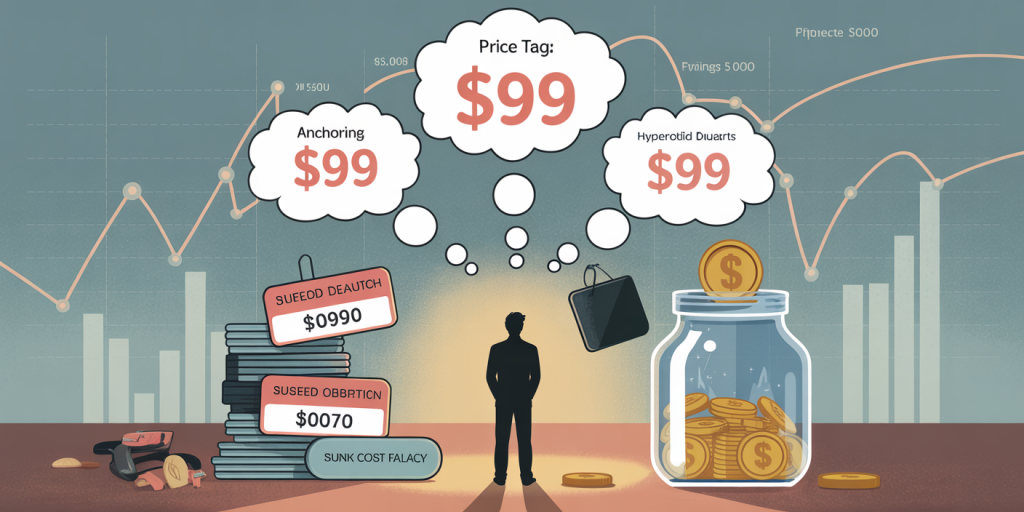The Psychology of Money: How Your Mindset Shapes Your Spending
Anúncios
Money is more than just currency; it encapsulates emotional, cognitive, and behavioral dimensions influencing how individuals interact with their finances. The psychology behind money plays a pivotal role in shaping spending habits, financial decisions, and ultimately, wealth accumulation or depletion. Understanding the psychological factors that govern money-related behaviors can empower individuals to develop healthier financial habits and better control over their monetary resources.
Money often triggers complex emotional responses ranging from anxiety to elation, impacting decision-making processes in ways that are not always rational. For example, a person growing up in financial scarcity may develop a scarcity mindset that drives overspending when opportunities arise, while someone raised in abundance might exhibit more calculated financial behaviors. This article delves into how mindset shapes spending, the psychological frameworks behind financial decisions, and actionable strategies to harness your mental approach for financial success.
Anúncios
The Emotional Connection Between Mindset and Money
Our mindset comprises beliefs, attitudes, and emotional responses about money, which guide how we save, spend, or invest. Emotions such as stress, insecurity, and fear often dominate these attitudes, even subconsciously influencing spending decisions. For instance, retail therapy—a behavior where individuals shop to alleviate emotional distress—highlights how emotions directly impact financial choices.
Neuroscience supports these notions. Research published in the *Journal of Consumer Psychology* (2021) shows that brain regions linked to reward processing become activated during spending, especially when buying luxury or non-essential goods. This neural activation can explain impulsive purchases: the immediate emotional gratification overrides long-term financial planning. Consequently, individuals with emotional spending tendencies risk accumulating debt or falling into financial instability.
Conversely, a positive money mindset encourages prudent financial behaviors. Psychologist Brad Klontz’s studies reveal that individuals believing money is a tool for empowerment and security are more likely to adopt budgeting habits and regular saving. This reinforces the notion that reshaping emotional responses to money can alter financial trajectories.
Cognitive Biases That Influence Spending Decisions
Cognitive biases often distort how we perceive and use money. These biases create systematic errors in judgment that influence financial behavior, frequently leading to suboptimal outcomes.
Anchoring Bias
Anchoring bias occurs when an individual relies heavily on the first piece of information encountered. For example, if a shopper sees a jacket priced at $300 marked down to $150, the original $300 serves as an anchor, making $150 seem like a bargain, even if the jacket’s actual value is closer to $100. This can lead to impulsive spending under the illusion of savings.
Sunk Cost Fallacy
The sunk cost fallacy persuades people to continue investing in a losing endeavor because of past investments. For example, someone might continue paying for an unused gym membership just because they already paid for the year, despite not using it. In spending, this bias might manifest as continuing to maintain expensive subscriptions or memberships that no longer provide value.
Hyperbolic Discounting
People tend to favor immediate rewards over future benefits — a phenomenon called hyperbolic discounting. This bias explains why it can be challenging to save money for retirement when immediate gratification through spending tempts them more. Data from a 2020 Pew Research Center study found that 48% of Americans struggle to save money due to a preference for immediate spending, illustrating the real-world impact of this cognitive bias.
Understanding these biases can help consumers recognize irrational spending triggers and develop counter-strategies to improve money management.
| Cognitive Bias | Description | Financial Impact | Example |
|---|---|---|---|
| Anchoring Bias | Reliance on initial number or value | Overspending due to perceived deals | Paying $150 for a jacket “originally $300” |
| Sunk Cost Fallacy | Continuing investment due to past costs | Wasteful spending | Maintaining unused subscriptions |
| Hyperbolic Discounting | Preference for immediate reward over larger future gain | Difficulty in saving money | Choosing a vacation now over retirement savings |
Cultural and Social Influences on Spending Behavior


Money mindsets are not formed in isolation; they are heavily influenced by cultural and social factors. These external forces shape attitudes toward money from childhood through adulthood.
In collectivist cultures, for instance, spending habits often prioritize family needs over individual desires. Asian and Latin American societies may encourage pooling resources for communal benefit, whereas Western individualistic societies emphasize personal wealth accumulation. This social context impacts how people allocate their finances.
Peer influence also plays a substantial role in spending decisions. Social comparison theory explains that individuals constantly evaluate their financial status relative to others. A study by Barclays (2019) found that 44% of consumers make purchases to keep up with friends or social media trends. This phenomenon, sometimes termed “conspicuous consumption,” can drive unnecessary spending and disrupt personal financial goals.
Additionally, advertising strategically exploits these social pressures by associating products with status, happiness, or acceptance. The psychological effect of wanting to “fit in” may override critical assessment of spending decisions.
Developing a Healthy Money Mindset for Better Spending
Cultivating a positive and realistic money mindset requires intentional psychological work combined with practical financial planning. Cognitive-behavioral strategies can modify negative beliefs and reduce impulsive spending.
One technique involves journaling about money attitudes. Writing down feelings related to spending, saving, or debt can help uncover unconscious biases and emotional triggers. For example, recognizing that certain purchases are linked to stress rather than need can foster controlled spending habits.
Setting clear, achievable financial goals also anchors spending decisions. Behavioral economist Dan Ariely highlights the effectiveness of “pre-commitment devices” such as automated savings, which reduce reliance on willpower and promote disciplined finances.
Moreover, education on financial literacy equips individuals with knowledge to combat biases and misleading marketing tactics. According to a 2022 National Endowment for Financial Education report, people who receive financial education are 30% more likely to maintain emergency savings and 20% less likely to carry credit card debt.
Practical steps to bolster a healthy money mindset include: Creating monthly budgets to track income and expenses Differentiating between wants and needs before purchases Practicing mindfulness to resist emotional spending urges Seeking professional financial advice to navigate complex decisions

These approaches empower individuals to align spending habits with long-term financial security and personal values.
Case Studies: Mindset Shifts Leading to Financial Transformation
Real-life examples demonstrate how changing one’s mindset about money can drastically improve financial wellbeing.
Case Study 1: Overcoming Impulsive Spending
Jessica, a 28-year-old marketing professional, struggled with impulsive buying, often exceeding her credit card limits. After attending a financial psychology workshop, she identified emotional spending habits linked to low self-esteem. By practicing mindfulness and setting strict spending limits, Jessica reduced her discretionary spending by 40% in six months, enabling her to pay off $5,000 in credit card debt and start an emergency fund.
Case Study 2: Embracing Abundance Mindset
Mark, a small business owner, grew up in poverty and initially feared investing money. His scarcity mindset inhibited wealth building. By reading financial self-help literature and engaging with a financial coach, Mark developed an abundance mindset—viewing money as a tool for growth rather than a finite resource. This shift empowered him to invest cautiously in his business expansion, increasing annual revenue by 25% and doubling his savings in two years.
These cases illustrate the profound influence mindset changes can have on spending efficacy and financial progress.
Future Perspectives: The Evolving Psychology of Money
The intersection of technology, economics, and psychology continues to redefine how people relate to money. Digital wallets, cryptocurrencies, and AI-driven financial apps offer new paradigms for spending and saving, influencing psychological interactions with money.
Emerging research hints at the potential of behavioral finance technologies personalized to individual money mindsets. For example, AI algorithms could detect irrational spending patterns in real-time and provide cognitive behavioral therapy (CBT)-style interventions to curb detrimental behavior.
Moreover, the increasing emphasis on mental health and wellness integrates financial psychology as a core component of holistic wellbeing. As society recognizes the link between stress, money anxiety, and physical health, future financial education and therapy likely will incorporate advanced psychological techniques to foster healthier money mindsets.
Finally, as environmental awareness grows, sustainable spending—a mindset considering ecological impact—will gain prominence. Financial decisions influenced by values, not just self-interest, signify a broader evolution in money psychology aligning personal finance with societal and planetary health.
—
This exploration into the psychology of money underscores the critical role mindset plays in shaping spending behaviors. By understanding emotional influences, cognitive biases, social pressures, and adopting strategies to cultivate healthier money attitudes, individuals can transform their financial futures. The ongoing convergence of psychology and technology highlights promising tools to support this evolution, fostering greater financial wellness for generations ahead.
